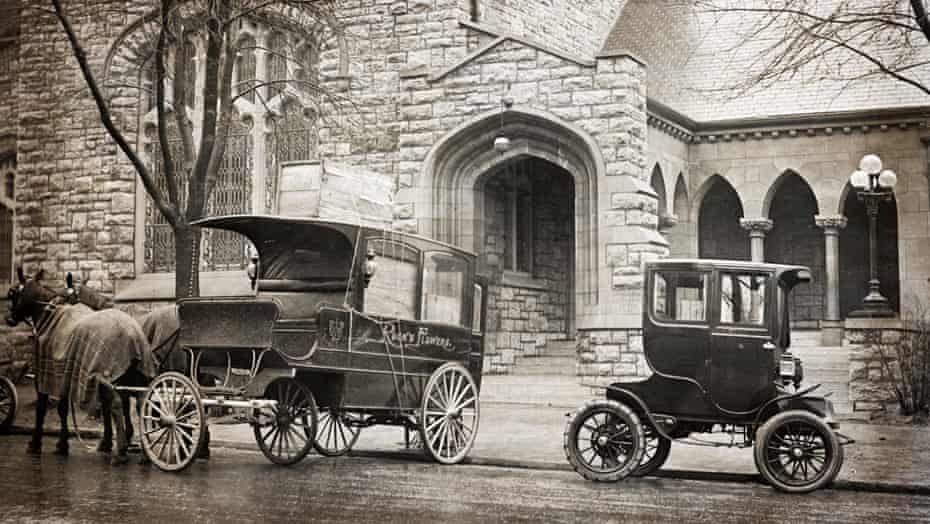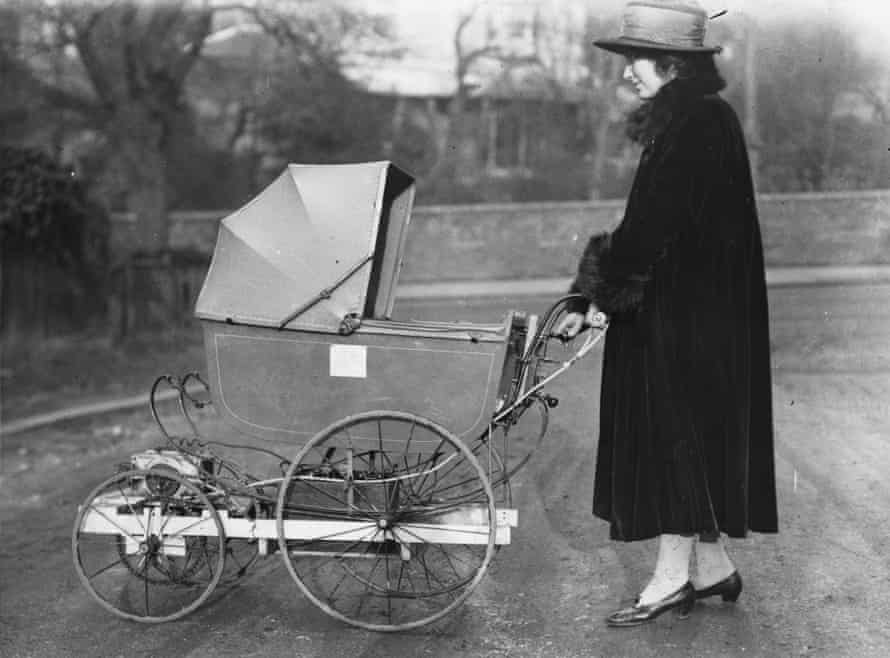
Shock of the Old: the Amazing, Infuriating History of the Electric Car – in Pictures
Believe it or not, battery-powered vehicles have been around since Victorian times – everything from private automobiles to taxis, ambulances and tricycles. We’ve got the photos to prove it
by Emma Beddington,
The history of the electric car is surprisingly enraging. If you imagine early electric vehicles at all (full disclosure: I didn’t until recently), it will probably be as the quixotic and possibly dangerous dream of a few eccentrics, maybe in the 1920s or 1930s, when domestic electrification became widespread. It’s easy to imagine some stiff-collared proto-Musk getting bored of hunting and affairs, eyeing his newly installed electric lights speculatively, then wreaking untold havoc and mass electrocutions.
The reality is entirely different. By 1900, a third of all cars on the road in the US were electric; we’re looking at the history of a cruelly missed opportunity, and it started astonishingly early. The Scottish engineer Robert Anderson had a go at an electric car of sorts way back in the 1830s, though his invention was somewhat stymied by the fact rechargeable batteries were not invented until 1859, making his crude carriage something of a one-trick pony (and far less useful than an actual pony).
Read Also:
Armed Attacks in Mexico Leave 24 People De@d Including 12 Police Officers (photos/videos)
Hackers Can Use ChatGPT to Steal your Private Data
It’s debatable whether Scotland was ready for this brave new world anyway: in 1842, Robert Davidson (another Scot, who had, a few years earlier, also tried his hand at an electric vehicle) saw his electric locomotive Galvani “broken by some malicious hands almost beyond repair” in Perth. The contemporary consensus was that it was attacked by railway workers fearful for their jobs.
Despite this unpromising start, electric vehicles had entered widespread commercial circulation by the start of the 20th century, particularly in the US. Electric cabs crisscrossed Manhattan, 1897’s bestselling US car was electric and, when he was shot in 1901, President McKinley was taken to hospital in an electric ambulance. London had Walter Bersey’s electric taxis, and Berlin’s fire engines went electric in 1908; the future looked bright, clean and silent.
But by the 1930s, however, the tide had definitively turned against electric, cursed by range limitations and impractical charging times while petrol gained the upper hand thanks partly – and ironically – to the electric starter motor. The Horseless Age magazine, which vehemently backed the petrol non-horse, would have been delighted. There was a brief resurgence of interest in the late 1960s, when the US Congress passed a bill promoting electrical vehicle development, but nothing much actually happened until the Nissan Leaf sparked interest in 2009. Electric still isn’t quite there yet, battling infrastructure and battery problems that might have been familiar to Anderson and friends.
Anyway, here’s what all this history looked like. Whisker warning: I hope you like moustaches, because there are lots.
1. Thomas Edison, 1895
.
Thomas Edison with his electric car, circa 1895.
Famously keen on electricity, Thomas Edison owned several electric cars (and designed batteries), but apparently Mrs Edison usually drove. “The great inventor was not a very good driver, often making contact with ditches and trees!” according to the Edison Innovation Foundation.
2. Charles Jeantaud, 1898
The electric cab, designed by the French engineer Charles Jeantaud, circa 1898.
French engineer Charles Jeantaud created the Tilbury, a contender for first battery-powered electric car, in 1881. This is the Jeantaud Cab No 25. I love how it copies the horse-drawn Hansom; it looks like Jeantaud should be chivvying it along with a whip. The moustaches peeping out are racing driver Count Gaston de Chasseloup-Laubat and his brother Louis. Chasseloup-Laubat broke multiple speed records in Jeantaud electric cars.
3. Camille Jenatzy and La Jamais Contente
Camille Jenatzy, in the driver’s seat, the first person to exceed 100kph (62mph) in an electric car.
Chasseloup-Laubat and Jeantaud’s great rival in the fin de siècle Wacky Races was the ginger-bearded “Red Devil”, Camille Jenatzy. The two regularly broke each other’s records before Jenatzy had the last word in 1899, recording a speed of 65.792mph (105.882 kph) in his self-designed electric suppository, La Jamais Contente (meaning never satisfied). Maybe at that point the Belgian was finally content?
4. Baker Electrics advert, 1910
A poster for Baker Electrics.
Electric cars swiftly became the woman’s choice: quieter, cleaner and no need to hand-crank (more gloomily, in his history of motoring, Tom Standage suggests their limited range might have attracted men keen to keep tabs on their spouses). Even Clara Ford – Henry’s wife – drove one. In this 1910 advertisement, a woman drives her husband to golf. She’s probably looking forward to sitting next to that nice quiet dog instead of listening to him complain about his caddy.
5. Electric car next to horses and wagon, 1910
A horse and cart next to an electric vehicle in Kansas City, Missouri, in 1910.
Remember the Great Horse Manure Crisis of 1894? Back then, Manhattan’s 100,000 horses produced more than 1,100 tonnes of excrement a day, with one observer describing the city as “literally carpeted with a warm, brown matting”. The danger of cities drowning in horseshit was extremely real and terrifying, so vehicles like this dainty little Smart ancestor must have felt like the futuristic answer to their prayers. Now people use the crisis’s painless resolution to argue against tackling the climate crisis, because unfortunately, no amount of progress has cured stupidity.
6. Electric pram, 1921
Mrs P Mackenzie with an electrically powered baby carriage.
Other electric modes of transport were also available: Gustave Trouvé’s 1881 weirdly asymmetrical tricycle, for instance, which looks like something a man in London’s Dalston might ride (a sketch of it shows dogs and top-hatted men convulsed with shock). This electric baby carriage modelled by the elegant Mrs P Mackenzie never caught on, but why not? The patriarchy, that’s why.
7. Electric car in Paris, 1941
An electric car and Madeleine-Bastille double-decker in Paris.
The picture dates from the German occupation of Paris, when people had a few things on their minds, yet the passengers of the horse-drawn double-decker are riveted by the appearance of … an electrified bath tub? Understandably. Note the tongue-twister shoe shop name behind – try saying that after a glass of beaujolais nouveau.
8. Dairy workers load a milk float, Blackpool
Workers loading milk on to electric delivery van.
Workers loading milk on to electric delivery vans.
The milk float is an electric survivor and cultural icon: Michael Caine hitched a ride on one in The Italian Job; Linford Christie raced one; the evil mustachioed milkman Ted Mustard booby-trapped his in a Father Ted parody of Speed. They’ve enjoyed a resurgence since Covid – the New York Times even wrote one of its “isn’t Britain quaint” articles about the phenomenon.
9. Amitron prototype, 1967
The American Motors prototype, the Amitron.
The American Motors prototype, the Amitron.
The Amitron is how I assumed early electric car ads would look: groovy chick in kinky boots showing off something Capt Kirk might drive around a hostile planet. It was supposed to have air-filled seats and a 150-mile range at 50mph but never got beyond the prototype stage “due to several technical issues”.
10. The Sinclair C5, 1985
The C5 in 1985
The C5 in 1985.
In a crowded field, the Sinclair C5 is possibly Britain’s daftest cultural artefact of the 1980s: part Reliant Robin, part mobility scooter, all absurdity. I had forgotten how terrifyingly small they were (demonstrated by 14-year-old Joe Paine above); footage of adults in them makes the C5 look more like a Little Tikes ride-on than serious vehicle. But was it actually so absurd? Twenty miles for 5p and emissions-free roads remain a distant dream in 2023; maybe the joke is on us.
Source: Guardian.com











